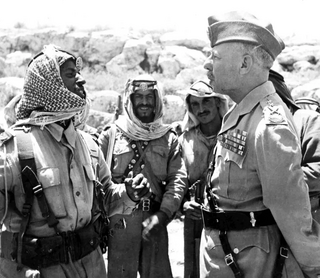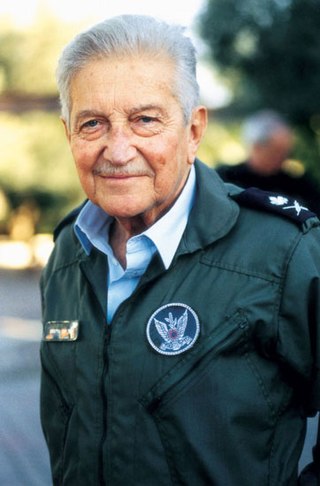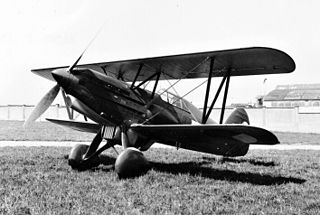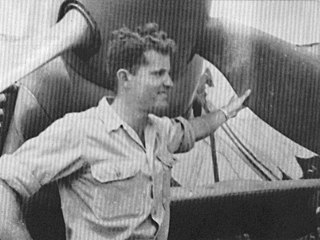
The 1948 Arab–Israeli War, also known as the First Arab–Israeli War, followed the civil war in Mandatory Palestine as the second and final stage of the 1948 Palestine war. The civil war became a war of separate states with the Israeli Declaration of Independence on 14 May 1948, the end of the British Mandate for Palestine at midnight, and the entry of a military coalition of Arab states into the territory of Mandatory Palestine the following morning. The war formally ended with the 1949 Armistice Agreements which established the Green Line.

The Avia S-199 is a propeller-driven Messerschmitt Bf 109G-based fighter aircraft built after World War II using the Bf 109G airframe and a Junkers Jumo 211F engine in place of the original and unavailable Daimler-Benz DB 605 engine. It is notable as the first fighter obtained by the Israeli Air Force, and used during the 1948 Arab-Israeli War.

Ezer Weizman was an Israeli military general and politician who served as the seventh President of Israel, first elected in 1993 and re-elected in 1998. Before the presidency, Weizman was commander of the Israeli Air Force and Minister of Defense.

The Avia B-534 is a Czechoslovak biplane fighter developed and manufactured by aviation company Avia. It was produced during the period between the First World War and the Second World War. The B-534 was perhaps one of the most well-known Czechoslovakian aircraft of the era.

Hatzor Airbase, also titled Kanaf 4 is an Israeli Air Force (IAF) base, located in central Israel near kibbutz Hatzor Ashdod after which it is named. However, there have been no fighter jets stationed there since 2021, only patrol aircraft, UAVs and defense missiles. A Combined Operations Center for the US military and Israel has also been built there in 2021.

The Sherut Avir was the air force of the Haganah and the forerunner of the Israeli Air Force.

101 Squadron of the Israeli Air Force (IAF), also known as the First Fighter Squadron, operates F-16C Fighting Falcon Barak out of Ramat David Airbase.

Between June 1947 and October 31, 1949, the Jewish agency seeking weapons for Operation Balak, made several purchases of weapons in Czechoslovakia, some of them of former German army weapons, captured by the Czechoslovak army on its national territory, or newly produced German weapons from Czechoslovakia's post-war production. In this deal, sale activities of Czechoslovak arms factories were coordinated by a special-purpose department of the Československé závody strojírenské a kovodělné, n.p. Holding, called Sekretariát D, headed by Gen. Jan Heřman (ret.).

The Czechoslovak Air Force or the Czechoslovak Army Air Force was the air force branch of the Czechoslovak Army formed in October 1918. The armed forces of Czechoslovakia ceased to exist on 31 December 1992. By the end of the year, all aircraft of the Czechoslovak Air Force were divided between the Czech Air Force and the Slovak Air Force.

Gordon Levett (1921–2000) was a former Royal Air Force pilot in World War II who volunteered for a covert mission to fly supplies including dismantled fighter planes into the fledgling state of Israel in its 1948 Arab–Israeli War as part of Operation Balak. Later Levett joined the first squadron of the newly created Israeli Air Force, helping establish a permanent Israeli military and aiding in the founding of the state of Israel. Levett was the only English gentile pilot in the Israeli Air Force, where he rose to the rank of lieutenant colonel.

115 Squadron, also known as the Flying Dragon or Red Squadron, is the Israeli Air Force's aggressor squadron. Based at Ovda, it is the sole IAF squadron to operate fixed-wing aircraft, helicopters and ground-based assets.

Mordechai "Modi" Alon was an Israeli fighter pilot who with the formation of the Israeli Air Force in May 1948, assumed command of its first fighter squadron. Flying the Avia S-199, Alon participated in the IAF's first combat sortie on 29 May 1948, and on 3 June scored the IAF's very first aerial victories, downing a pair of Royal Egyptian Air Force C-47s over Tel Aviv.

Milton Rubenfeld was an American pilot who flew for the Royal Air Force and U.S. Army during World War II, later becoming one of the five founding pilots of the Israeli Air Force in the 1948 Arab–Israeli War. It is widely believed that Rubenfeld, the other four volunteer pilots, and the other machalniks changed the course of the 1948 Arab–Israeli War. He was injured and returned to the United States, and settled in New York state, where he married and owned a local business with his wife, Judy. Later, he moved his family to Sarasota, Florida, where he and his wife owned another successful business until he retired. He died in 2004. He was the father of actor/comedian Paul Reubens, who was known for creating and portraying the character Pee-wee Herman.

The History of the Israel Air Force begins in May 1948, shortly after the formation of the State of Israel. Following Israel's declaration of independence on May 14, its pre-state national institutions transformed into the agencies of a state, and on May 26, 1948, the Israeli Air Force was formed. Beginning with a small collection of light aircraft, the force soon transformed into a comprehensive fighting force. It has since participated in several wars and numerous engagements, becoming what has been described as "The mightiest air force in the Middle East".

Josef Stehlík was a Czech fighter ace. In World War II he served in the French Air Force and then the Royal Air Force Volunteer Reserve. In 1944 he transferred to the Eastern Front, where he commanded the 1st Czechoslovak Independent Fighter Air Regiment.
George Lichter was an American fighter pilot and one of the founders of the Israeli Air Force.

Sam Lewis was an American pilot who flew transport aircraft as a foreign volunteer in Israel's war for Independence and as chief pilot for Israel's national airline, El Al.
The Israeli Air Force bombarded a residential neighborhood near Qasr al-Qubba in Cairo on July 15, 1948, during the international phase of the 1948 Palestine war. The attack was carried out during the breaking of the fast of Ramadan and killed 30 civilians and destroyed many homes. It led to an angry march on the Jewish quarter.
Royal Air Force Beit Daras or more simply RAF Beit Daras is a former Royal Air Force station located in Bayt Daras, Israel.
















